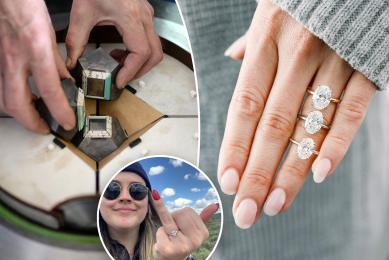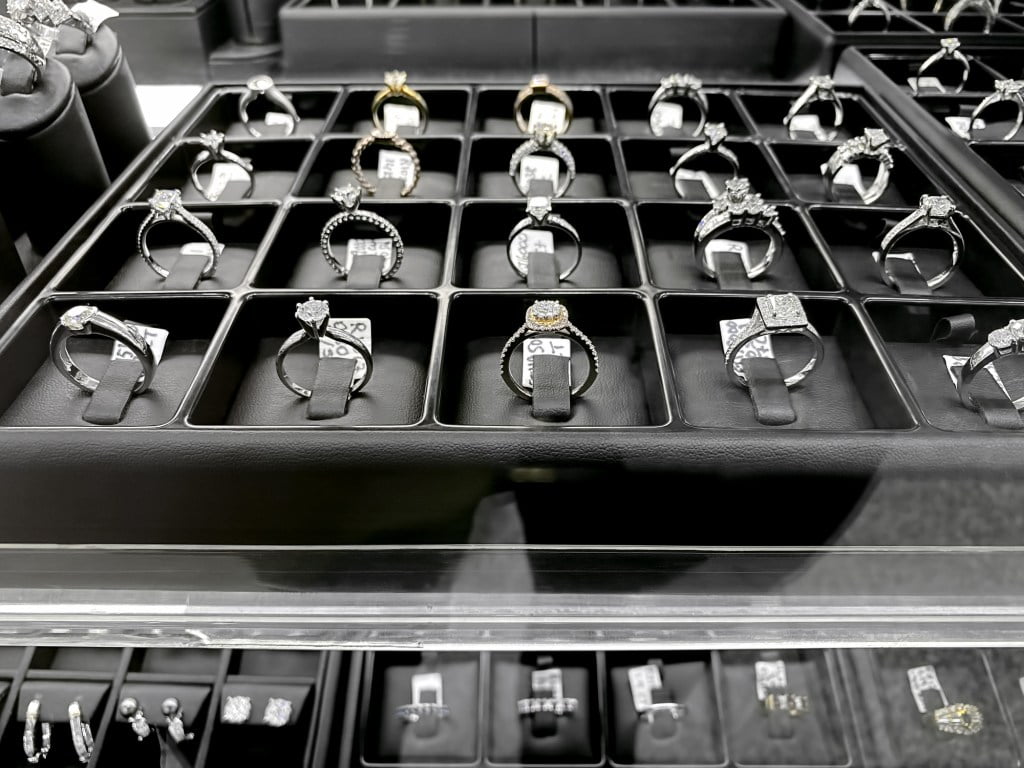In the midst of a changing industry, diamond prices have taken a dramatic fall, with a sharp 25% plunge as lab-grown diamonds morph into a fierce competitor. Diamond giant De Beers, sensing the changing tide, has boldly chopped the price of its exquisite solitaires due to falling sales as more and more bargain-seeking fiancées show a growing preference for cheaper, lab-produced gems. Even bigger drops in price have been applied to certain categories of mined diamonds – those large, uncut gems that are expertly carved into smaller, polished stones that find their way into top-quality bridal rings. This industry shakeup is largely driven by synthetic diamonds gaining significant mainstream popularity, forcing established industry players to rethink their strategy and pricing.
1. The Diamond Pricing Paradigm Shift
In recent times, there has been a sharp decrease in traditional diamond prices. This can largely be attributed to two significant factors – the emergence of lab-grown diamonds and the shifting consumer behavior towards these alternatives.
The sharp decrease in traditional diamond prices
Over the past few years, the pricing of traditional diamonds has experienced a drastic fall. The cost of these precious gemstones has been reduced by up to 25%, highlighting the weakening demand for these traditionally sought-after gems in the current market. This has led to significant changes within the diamond industry, affecting both suppliers and consumers.
The role of lab-grown diamonds in the price change
One of the primary causes behind the decrease in diamond prices has been the rise of lab-grown diamonds. Almost impossible to distinguish from their mined counterparts to the naked eye, these man-made gems are offering consumers a more cost-effective alternative. As such, the growing popularity of lab-grown diamonds is putting downward pressure on the prices of traditional diamonds.
The shift in consumer demand toward lab-grown alternatives
Another contributing factor to the decline in traditional diamond prices is a change in consumer demand. There is an increasing inclination towards lab-grown alternatives, primarily because they are cheaper than mined diamonds. This shift in consumer preference is forcing diamond industry players to adjust their pricing structures in order to stay competitive in the market.
2. The Major Diamond Industry Players’ Response
The recent changes in the diamond market have prompted significant responses from key industry players, such as De Beers and Alrosa PJSC. These companies are employing different strategies in an attempt to navigate the shifting industry landscape.
De Beers’ significant price cuts amid declining sales
Reacting to declining sales, De Beers drastically slashed the pricing of their precious solitaires in an effort to compete with cheaper lab-grown gems. This move saw some mined diamond categories experiencing a price reduction of up to 25%, as the firm battled with low demand and surplus stock.
Alrosa PJSC’s sales halt to regulate market prices
Another major player in the diamond industry, Russia’s Alrosa PJSC, responded to the changing market by temporarily halting sales for two months to help regulate plunging prices. By limiting supply, the company hoped to stabilize market prices and revive consumer interest in mined diamonds.
India’s temporary import ban to alleviate oversupply issues
The Indian diamond market, which is a significant contributor to the global diamond industry, also implemented strategies to address oversupply issues. The country’s diamond industry leaders voluntarily suspended rough diamond imports for two months. The objective was to clear out the abundance of rough and polished gems and prevent further decline in prices.
3. Lab-Grown Diamonds: The Cost-Effective Alternative
The development and increased popularity of lab-grown diamonds are causing industry disruptions. These alternatives are attractive to consumers due to their cost benefits and quality that is virtually indistinguishable from mined diamonds.
The development and popularity of lab-grown diamonds
Lab-grown diamonds have become more common and popular in recent years. They can be created much more efficiently and cost-effectively than mined diamonds, which has increased their appeal to consumers. Moreover, lab-grown diamonds offer a more ethical and sustainable alternative to mined diamonds, further enhancing their appeal to the modern consumer.
The cost benefits of lab-grown diamonds over mined diamonds
From a pricing perspective, lab-grown diamonds are typically 60% to 85% cheaper than mined diamonds. This significant price difference is enabling more and more consumers to be able to afford diamonds, thereby fueling the demand for these lab-grown alternatives.
The virtually indistinguishable quality between lab-grown and traditional diamonds
The quality of lab-grown diamonds is virtually indistinguishable from that of mined diamonds. This means that consumers can enjoy the beauty and charm of diamonds at a fraction of the price without compromising on quality, further contributing to their growing popularity.
4. The Financial Impact on Diamond Mining Companies
The rise of lab-grown diamonds undoubtedly poses significant challenges for diamond mining companies. From affecting financial performances to presenting economic obstacles, mining companies are being forced to strategize new ways forward.
The effect on De Beers financial performance
The growing affinity for lab-grown diamonds and the resulting slash in prices of traditionally mined diamonds have adversely affected De Beers’ financial performance. With declining sales and surplus stock, the company has been grappling with weak demand resulting in significant financial implications.
The economic obstacles for diamond mining companies amidst the rise of lab diamonds
For diamond mining companies, the rise of lab-grown diamonds presents a considerable economic challenge. The significant cost benefits associated with lab-grown diamonds mean that they are able to undercut the pricing of mined diamonds, making it increasingly difficult for mining companies to compete.
Potential strategies for mining companies moving forward
Moving forward, diamond mining companies may need to adopt new strategies to navigate the changing industry landscape. This might include finding ways to differentiate their products from lab-grown alternatives, develop marketing strategies focusing on the rarity and uniqueness of mined diamonds, or even venturing into the lab-grown diamond market themselves.

5. The Wedding Industry’s Response to Lab-Growns
The rise of lab-grown diamonds is also having a noticeable impact on the wedding industry, particularly in the bridal ring market. Consumers are increasingly choosing lab-grown diamond engagement rings, which is having a significant impact on overall wedding budgets.
The bridal ring market’s shift toward lab-grown diamonds
Traditionally, the bridal ring market has been dominated by mined diamonds. However, with the rise of lab-grown diamonds, there has been a marked shift towards these cost-effective alternatives. Brides and grooms-to-be are increasingly opting for lab-grown diamonds for their engagement and wedding rings, significantly affecting the market’s dynamics.
The growing demand for lab-grown diamond engagement rings
The demand for lab-grown diamond engagement rings has been growing consistently over the years. These rings offer couples the opportunity to save on their purchases without compromising on the quality or appearance of their precious gem, which has naturally resulted in increased demand.
Impact on overall wedding budgets
The shift towards lab-grown diamond rings is positively impacting overall wedding budgets. Engagement rings typically account for a significant portion of a wedding budget, and opting for lab-grown diamond rings allows couples to allocate a larger portion of their budget toward other aspects of their wedding, such as the venue, catering, or honeymoon.
6. The Future of Diamond Retail
As retail prices adjust to the growing prevalence of lab-grown gems, the diamond retail market is set to experience several changes. These include predicted market trends and an anticipated consumer response to lower diamond prices.
How are retail prices adjusting to lab-grown gem prevalence?
The prevalence of lab-grown gems is compelling retailers to adjust their prices. As more and more consumers opt for these cheaper alternatives, retailers are being forced to lower their prices to remain competitive in the market.
Predicted market trends in diamond retail
The diamond retail market is predicted to continue evolving, largely due to the growing demand for lab-grown diamonds. Retailers are likely to find innovative ways to cater to this changing consumer preference, possibly through diversified offerings or specialized marketing strategies.
The anticipated consumer response to lower diamond prices
Consumers are expected to respond positively to lower diamond prices. The affordability of lab-grown diamonds is likely to attract a larger consumer base, thereby having a domino effect on overall demand and prices.

7. Implications for the Gemological Study and Standards
The growth of lab-grown diamonds also has implications for gemological study and standards. From changes in standards to ethical considerations, there are several key aspects that need to be addressed.
Any changes in gemological standards for lab-grown diamonds
Gemological standards for lab-grown diamonds remain consistent with those for mined diamonds, ensuring that consumers are receiving high-quality gems regardless of their origin. However, it is important for these standards to continue to evolve to accommodate the growing prevalence of lab-grown diamonds in the marketplace.
The scientific process of creating lab-grown diamonds
Creating lab-grown diamonds is a scientific process that, while more efficient than mining, still requires a great deal of precision and expertise. Gems are created under high-pressure, high-temperature conditions that mimic the natural diamond formation process.
The ethical considerations of lab-grown diamonds
Lab-grown diamonds present significant ethical benefits over mined diamonds, as they bypass the environmental harm and potential human rights issues associated with diamond mining. This ethical aspect is another factor contributing to their growing appeal, particularly among conscious consumers.
8. Consumer Perspectives on Lab-Grown Diamonds
From the consumer’s perspective, there are several factors to consider when it comes to lab-grown diamonds. These include opinions on quality, perceived value, and future trends in light of lowered diamond prices.
Consumer opinions on the quality of lab-grown diamonds
Most consumers find the quality of lab-grown diamonds to be on par with that of mined diamonds. The beauty, allure, and durability of these man-made gems are comparable to mined diamonds, making them an attractive proposition for many.
The perceived value of lab-grown diamonds among consumers
In terms of perceived value, lab-grown diamonds are viewed highly by consumers, primarily due to their affordability. Given that their quality is virtually identical to that of mined diamonds, consumers perceive them to be of excellent value for money.
Future consumer trends in light of lowered diamond prices
Lowered diamond prices, thanks to the rise of lab-grown gems, are likely to influence future consumer trends. More consumers are expected to choose lab-grown diamonds, further fueling their popularity and possibly even leading to further price reductions.
9. Understanding the Lab-Grown Diamond Process
The process of creating lab-grown diamonds is both fascinating and innovative. From the technology involved to the time and resources required, it represents a significant advancement in gem production.
The technology behind growing diamonds in a lab
The lab-grown diamond process employs high-tech equipment to replicate the natural conditions under which diamonds form. This includes high-pressure, high-temperature conditions, and involves precise control over various elements and variables, contributing to the uniformity and quality of the resulting diamonds.
The time, resources, and cost of creating a lab-grown diamond
Creating a lab-grown diamond can take several weeks, but it is significantly faster and less resource-intensive than the natural diamond formation process. The cost of creating lab-grown diamonds is also significantly lower than mining natural diamonds, which contributes to their affordability.
The sustainability factor of lab-grown diamonds
Lab-grown diamonds offer a more sustainable alternative to mined diamonds. They use less water and energy, and their production does not involve mining or other activities that are harmful to the environment.
10. Final Thoughts on the Future of the Diamond Industry
The emergence of lab-grown diamonds and the resulting drop in traditional diamond prices has led to a paradigm shift in the diamond industry. Moving forward, key industry players will need to adapt to these changes and develop innovative strategies to stay competitive.
How might the industry adapt to the rise of lab-grown diamonds?
As lab-grown diamonds continue to gain popularity, the diamond industry will need to find ways to co-exist with this new alternative. This could include developing unique marketing strategies, diversifying their product offerings, or even exploring opportunities within the lab-grown diamond segment.
What does the price slash mean for the industry’s future?
The recent slash in diamond prices signifies a shift in demand from traditional to lab-grown diamonds. For the industry, this could mean embracing new product offerings and finding ways to differentiate and add value to traditional diamonds.
Predicted trends and shifts in the diamond market moving forward
Moving forward, the diamond market is likely to continue experiencing shifts. The rise of lab-grown diamonds will continue to influence pricing, consumer preferences, and industry practices. As the industry navigates these changes, the goal will be to maintain the allure of diamonds – both mined and made.

Frequently Asked Questions About Lab-grown Diamond and Diamond Prices:
1. Are lab-grown diamonds more sustainable?
Yes, lab-grown diamonds are more sustainable than mined diamonds. They require fewer natural resources and have a lower carbon footprint, making them a more environmentally friendly choice.
2. What are the advantages of buying a lab diamond over a mined diamond?
There are several advantages to choosing a lab-grown diamond. Firstly, they offer ethical sourcing, as they are produced in controlled environments without the risk of supporting unethical practices like child labor or conflict financing. Additionally, lab-grown diamonds are typically more cost-effective, allowing consumers to get a larger, higher-quality diamond for their money.
3. Do lab diamonds last as long as mined diamonds?
Yes, lab-grown diamonds last just as long as mined diamonds. They are chemically and optically identical, offering the same hardness, brilliance, and durability.
4. Can a jeweler tell if a diamond is lab-created?
While it was once challenging to distinguish lab-grown diamonds from mined diamonds, advancements in technology have made it possible for trained gemologists to identify them with specialized equipment.
